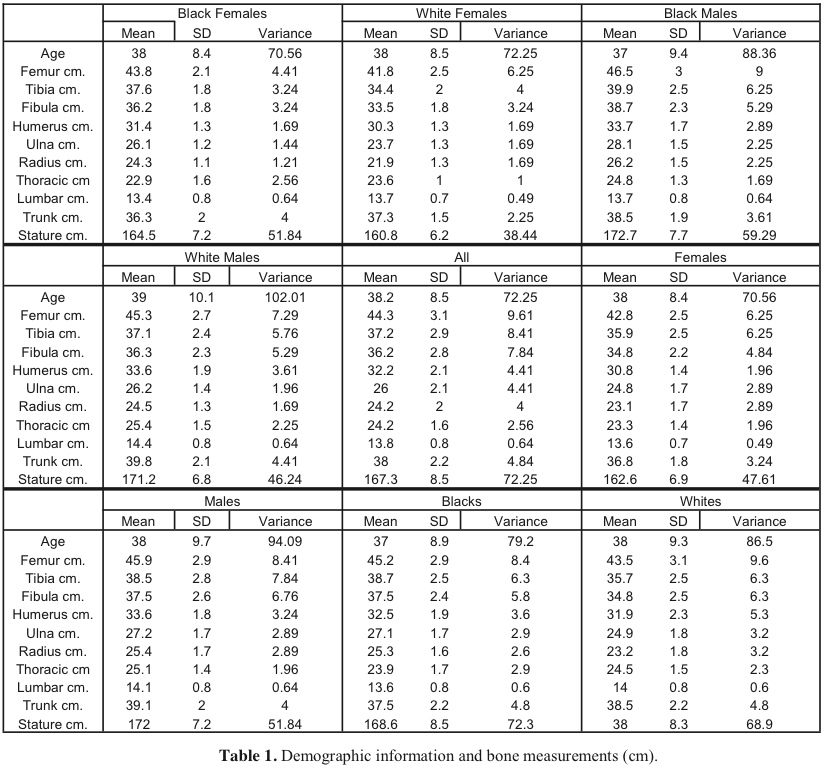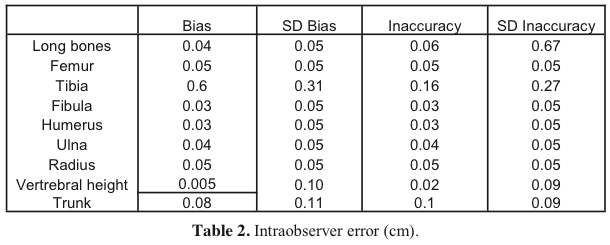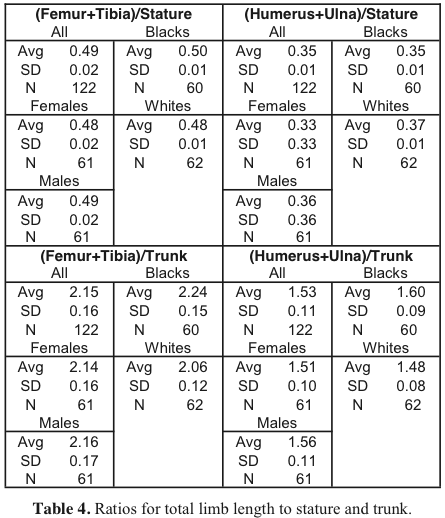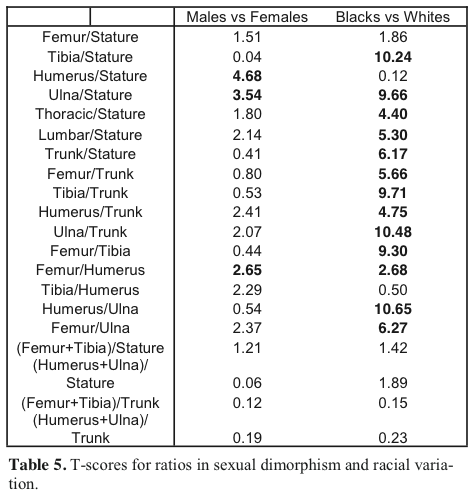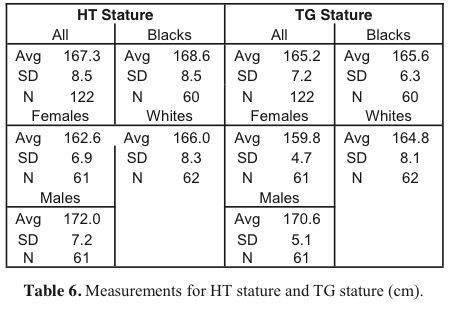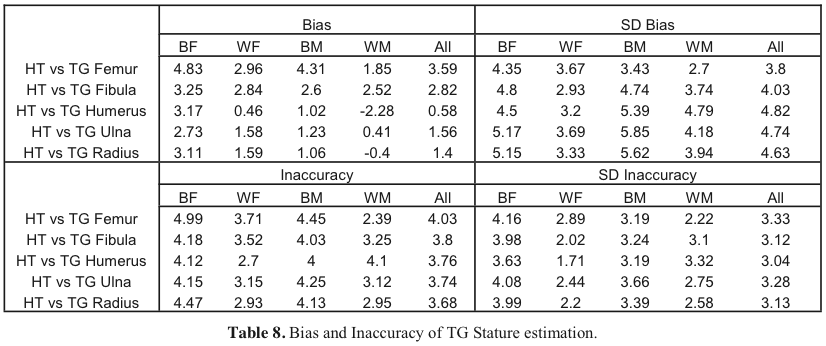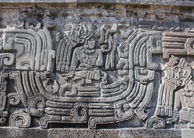From Discussions VOL. 5 NO. 1Covariation in Limb-limb and Limb-trunk Proportions in Whites and Blacks and Males in Females using the Hamann-Todd Collection, Cleveland Museum of Natural History
IN THIS ARTICLE
KEYWORDS
INTRODUCTIONStature estimation is traditionally an important consideration in physical anthropology and archaeology and is especially pertinent in the realm of forensics. The most widely used resource for estimating living stature from the length of long bones is the research of Trotter and Gleser (1952) (White, 2000). They studied the relationship between bone length and stature of American Blacks and Whites1 from the Terry Collection at the National Museum of Natural History. They also used records of the causalities from the Korean War (Trotter and Gleser, 1952). Their research is an important basis for the exploration of diversity within and between populations. Several other researchers have found variation in stature and limb proportions across many populations throughout the world. In a Croatian sample, Petrovecki et al. (2007) found that the humerus is the most accurate predictor of stature in females, and the tibia in males. Mendonca (2000) found that in a modern Portuguese population, the femur yields a better estimate for stature than the humerus, but these were the only two bones measured in this study. Radionova et al. (2002) found that the formulae provided by Trotter and Gleser do not describe the modern day Bulgarian population based on measurements of stature, the humerus, tibia and fibula. Steyn and Smith (2007) found significant differences among the statures of three South African populations; South African Whites (no African ancestry) are taller in both sexes than South African Blacks and South Africans of both European and African ancestry; however both groups with either all or some African ancestry are closer to each other than to the Whites. Celbis and Agritmis (2006) found that, among all long bones, the femur gives the best estimate of stature. Generally the order of correlation between length and stature from highest to lowest is: femur, tibia, fibula and the humerus (Hauser et al., 2005). However, this could be different in different genetic or chronological populations. Aside from differences between populations and regions, secular changes in overall stature and limb/ stature proportions distort the reliability of the original data on modern populations (Jantz, 1992; GordonLarsen et al., 1997; Ruff, 1994; Katzmarzyk and Malina, 1999, Hauser et al., 2005; Silventoinen, 2003). Genetics only play a part of the role in stature and allometric variation; environment contributes to about 20% of stature in the United States and Finland (Stunkard et al., 1986; Silventoinen, 2003). Jantz (1992) found that the femur-tibia proportion in Whites from the Forensic Anthropology Data Bank has decreased over time; modern Whites have longer shins compared to thighs than they have in the past. Conversely, the ratio has stayed the same in Blacks. Pretty et al. (1998) found that stature has been stable among the South Australian Aboriginal Murraylands. Duyar and Pelin (2003) found that there are different femur-tibia ratios among different groups based on stature and that the ratio increases as height increases. In every population, mean male stature is greater than mean female stature, but the degree of sexual dimorphism varies across populations (Holden and Mace, 1999). Holliday and Ruff (2001) found that the proximal limb segments (femur and humerus) tend to be more stable across populations compared to stature than the distal limb segments (tibia, fibula, ulna and radius). Males have a greater range of variance than females; both upper and lower distal limbs vary to the same degree in females, whereas in males the lower legs have a greater range than the lower arms. According to this phenomenon, it would seem that one would need to know the sex and race of the individual prior to estimation the stature. Iscan and Shihai (1995) found the knee to be more sexually dimorphic in the Chinese whereas the pelvis is more dimorphic in American Whites and Blacks. Overall, sexual dimorphism is best delineated with breadth and circumference measurements rather than total length of long bones. Determining sex via osteoscopic evaluation can yield an accuracy rate as high as 100%, as long as the evaluator understands sexual dimorphism in different populations (Iscan, 2005). Chibba and Bidmos (2007) found sexual dimorphism in the tibia of White South Africans with a wide variety of European descent. Stature could be best predicted in male tibiae by measuring the breadth of the proximal end, whereas in females, the breadth of the distal end is the most accurate. Asala et al. (2004) found that the part of the femur which contributes most to sexual dimorphism is the vertical diameter of the femoral head, with men having a larger diameter than women. In the distal end of the femur, the medial condylar length is longer in males than in females. Overall, the accuracy of this procedure ranges from 81.5 – 85.1%. Mall et al. (2001) found that in a sample of German men and women, the vertical diameter of the humeral head is the most (90%) accurate in determining sex. Several researchers have also attempted to apply modern-day stature estimation techniques to archaeological populations. Zakrzewski (2003) found a significant increase in stature in ancient Egyptians, which coincided with an increase in societal hierarchy and a dependence on agriculture from ca. 4000 BC to ca. 1900 BC. A greater increase was found in males than in females. Interestingly, there was an increase in all longbone length except for the fibula. There was also a significant decrease in the maximum length of the humerus relative to the ulna through time, indicating the adaptation of a more African body plan. Raxter et al. (2008) reconstructed stature on an ancient Egyptian population by using a revision of the Fully technique (Raxter et al., 2006). They found that ancient Egyptian body proportions were closer to modern American Blacks than to Whites, but not identical (Raxter et al., 2008). Giannecchini and Moggi-Cecchi (2008) found that stature fluctuated over time in three archaeological Italian samples; the lengths of the distal limb segments were more pronounced than the proximal limb segments. Sometimes the best evidence left behind at a crime scene or an archaeological site are fragmentary remains of long bones, in which case the bone would need to be reconstructed before one could apply a stature-regression formula. The Steele method was developed in the 1960's to reconstruct the length of long bones based on portions on the bone (Steele and McKern, 1969). Simmons et al. (1990) revised this method by defining specific landmarks which made it more feasible and accurate for other scientists to repeat the procedure. Holland (1992) also found a significant correlation between the proximal end of the tibia and stature, although the distal or mid-portions were not measured. It is important to note that using the proximal end of the tibia, or any fragment of a bone, should be used only in the absence of complete bones. The errors of estimate compound when stature is estimated by using an estimate of a long bone measurement. In this study, I will explore the co-variation of limb and trunk proportions in American Blacks and Whites. I will also test the reliability of the Trotter and Gleser (1952) stature estimation formulae to a sample from the Hamann-Todd Collection at the Cleveland Muesuem of Natural History.Continued on Next Page » Suggested Reading from Inquiries Journal
Inquiries Journal provides undergraduate and graduate students around the world a platform for the wide dissemination of academic work over a range of core disciplines. Representing the work of students from hundreds of institutions around the globe, Inquiries Journal's large database of academic articles is completely free. Learn more | Blog | Submit Latest in Anthropology |

